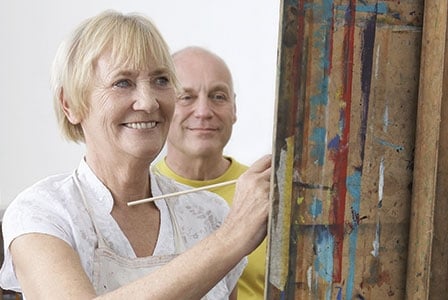
Art therapy, though relatively recent, is gradually gaining more mainstream acceptance as its body of supporting research expands.
Sticky finger paints, misshapen mounds of clay, and boxes of multicoloured crayons are often thought of as ingredients for children’s art projects. However, given the emotional and psychological benefits of art-making and creative play, perhaps adults should be reaching for the glitter glue, too.
Draw it out
When we have an unresolved issue in our lives and are seeking professional support, our first impulse may be to pursue traditional talk therapy. Although this is a popular and well-established field, a number of up-and-coming alternative therapies are also proving to be effective—such as art therapy.
What is art therapy?
The notion of art as healing isn’t new—cultures and traditions around the world have used art-making for centuries as a means to process their experiences and create a sense of community. Yet the field of art therapy is relatively recent, having emerged in the 1940s, and is gradually gaining more mainstream acceptance as its body of supporting research expands.
Art therapy is a combination of counselling and art-making that relies on the process of creative self-expression to help us externalize our thoughts and feelings. When we’re drawing, painting, and sculpting, we engage our senses in a way that may allow us to explore emotions in more depth than if we were simply talking them out. This visual and sensory focus also makes art therapy more accessible to individuals who may have difficulty expressing themselves verbally.
The focus isn’t on making beautiful artwork, but rather on the process of creating art, how we feel about the artwork, and what it means to us. Art therapists don’t interpret the art—their role is to support clients in finding their own meanings in the piece and to build supportive relationships with clients.
Depending on the approach of the therapist, the type of clients, and the time frame for therapy, art therapists may offer directives (such as “draw yourself as a tree”) or may leave it open for clients to decide for themselves what they need to do.
Generally, the basic materials used include paint, pastels, clay, pencil crayons, and markers; however, art therapy may also include a wide array of other supplies, from fabric and glue guns to objects found in nature such as rocks and leaves.
Who can benefit?
Art therapy is used with a wide range of populations—from children as young as four or five to adults in their 90s—and may be used in a number of different settings, including schools, nursing homes, addiction programs, hospitals, and community centres. It may be offered as a one-on-one session, with couples or families, in a group format, or even as a one-time workshop or retreat.
Researchers have found that art therapy may benefit people experiencing a number of different issues, including
- autism
- Alzheimer’s disease
- mental illness
- post-traumatic stress disorder (PTSD)
- chronic pain
- stroke recovery
- anxiety
- trauma
It may also be used with individuals without pressing their physical or psychological issues, as art therapy allows us to tap into our inner strengths—enabling personal growth, relaxation, and insight.
What are the benefits?
As we grow older, most of us hope that we’ll stay active, alert, content, and socially engaged. Art therapy can support us in aging vibrantly, providing a variety of social and mental benefits:
- a greater sense of community
- improved mood and self-esteem
- elevated cognitive functioning
- decreased anxiety
Further, art therapy may provide opportunities to explore our life purpose and create meaning—the colours, shapes, symbols, and metaphors that emerge from artwork are rich fodder for personal exploration.
Art therapy also enables us to get into a state of flow—total immersion in and enjoyment of an activity. This state is brought about due to the mind-body connection that happens in art-making, and also because art therapy requires engagement of both sides of the brain. Being in a state of flow encourages positive mood, personal growth, and overall well-being.
Although people who come to art therapy will have unique goals and issues, what they generally have in common is the desire to increase well-being and quality of life. Art therapy facilitates this by giving clients an opportunity to use art to engage with their feelings in a tangible, visual way—thereby offering moments for insight and processing.
How to find an art therapist
Locate an art therapist in your area by checking the listings/member directory on an art therapy association website:
- BC: bcarttherapy.com
- Ontario: oata.ca
- all of Canada: canadianarttherapy.org
Art therapists who are members of these associations are fully trained, have gone through a rigorous process to gain membership, and are part of an organization that encourages ethics, best practices, and continuing professional development.
What to expect when you see an art therapist
Ask questions
In your first art therapy session, you’ll have a chance to ask questions, discuss your reasons for attending art therapy, and express your hopes and expectations.
Make art
This will take up a significant portion of your time in art therapy. The art therapist is there to help you find materials that support your expression, to witness your creative process, and to provide general support.
Discuss
There will usually be time for you to discuss your artwork, what it means to you, and what the process was like. This may be a structured time at the end of the session or may happen naturally throughout.



